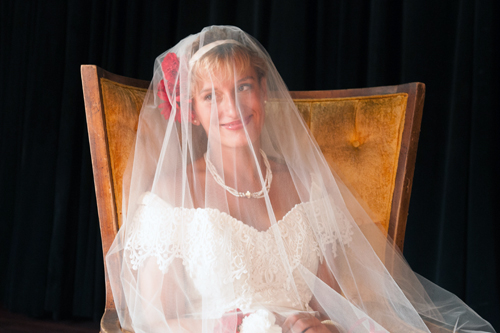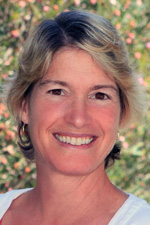
By Eva Trieger

SAN DIEGO — Nowadays it’s not too unusual for a wedding invitation to arrive via email, but the one for this past Labor Day was a little unusual. I was invited to a Yidishe Khasene (A Yiddish Wedding), a theatrical re-enactment of the wedding of Edward Meisarosh and Jana Mazurkiewicz Meisarosh.
A relative newcomer to America, Jana attended the University of Michigan, pursuing a PhD in the department of Slavic Languages and Literature. With her background of acting, directing and playwriting, the Yiddish theater is a natural home. Once on the San Diego scene, Jana sought out the insight and wisdom of world renowned Klezmer musician and SDSU professor, Yale Strom. Strom now sits on the board of advisors for Jana’s organization, YAAANA. Yiddish Arts and Academics Association of North America is dedicated to “promoting Yiddish language and culture through academic and artistic events and through food.”
This freydik gelegnhayt, joyous occasion, was replete with music, dancing, food, alcohol, storytelling, and laughter all shared by family and friends. As guests entered the hall, we were greeted by a slideshow featuring images of Polish families, homesteads and villages interspersed with pictures of Chagall paintings. The strains of Klezmer music were heard, and a full bar tempted guests with Polish vodka and rum. With bride and groom backstage, master of ceremonies and erstwhile rabbi, Yale Strom accompanied by his wife and singer Elizabeth Schwartz and bass player, Jeff Pekarek, started the fabrengen. Guests were invited to join in with spirited clapping. Strom narrated the event, providing explanations of tradition, ritual and history with a richness of culture laden stories.
Strom brought all of the guests into the realm by telling the tale of how one finds his intended or bashert. This is the belief that humans are born as incomplete and require a union with another to restore them to wholeness. Further, Strom as batkhn, part stand up, part Talmudic scholar, shared the story behind the Golem, a creature invented by the Maharal of Prague, Rabbi Yehuda Loew, to “beat up unruly Gentiles” and protect the Jews from “blood libel” and other assaults or accusation. Just as Shelley’s Frankenstein ran amok, so too, the Golem became a danger to the inhabitants of the shtetl and so Rabbi Loew removed from the Golem the sacred name of HaShem, rendering the monster impotent and lifeless.
The role of the batkhn, as emcee, is to make everyone sad initially, to set a somber, somewhat poignant tone for the wedding. This was accomplished by singing songs of lament and telling sad tales. The objective is to pluck at the guests’ heartstrings before enveloping them in the joy of the marriage. In this way, the ceremony ends on a high note with festivity and delight. To accomplish the creation of this woeful mood, Strom, Schwartz and Pekarek introduced the bride, to Strom’s wailing violin. This “moralizing song” accompanied the entrance of Jana, who was seated on an upholstered chair, downstage left. The bazetsen makes the bride Queen for a Year. As her marital status is changed, so must her physical appearance be in concert with her new role. To this end, the bride’s braids are cut off, causing her to cry at the loss of her innocence.
As the tempo and melodies of the music shifted to gleeful, Jana pranced around the room as Schwartz sang and played the tambourine. The bride-to-be was a sprightly hart with a freyd heart. Of course, the kale, or bride, was not the only joyful one! There was a tish, or a table for the groom, who was marched in while a Polish song was played. At this point it is customary that the khsn give a speech which reflects Torah, Talmud and a Yiddish curse or two. Our groom, Ed, upheld the thousand year old tradition with the following: May you have 100 houses, each with 100 rooms. May each room have 20 beds and may you be driven from one to another by a delirious fever!
After the speech, a chuppah was brought out. This canopy is open on four sides, reminiscent of Abraham’s tent, and all are invited to the wedding. It is customary that the poor are welcomed to the ceremony and ensuing feast. While members of the wedding party held the four corners, the witnesses stood by as Jana circled her groom seven times. The rabbi, watched as the groom placed a simple, plain ring on the index finger of the bride’s right hand. The ketuba was brought out and Strom explained that the document is written not in Hebrew, nor Polish, but in Aramaic, the same language as the kaddish, or prayer for the deceased.
Finally, after the vows were exchanged and the brachot were given, the groom stepped on a glass. The batkhn explained this is done to illustrate that we have sadness within our joy as we recalled the destruction of the Temple and the pogroms which have stolen our loved ones. It also affirms commitment in marriage. Strom explained that the fragility of the glass echoes the fragility of relationships, and that the bond of a marriage is stronger and more durable.
Jana’s organization YAAANA, in tandem with Strom and Schwartz at SDSU promote Yiddish culture through music, arts, and food and are always in search of committed volunteers and board members. Jana may be reached at https://tarbutonsd.wufoo.com and further works may be found at http://janamazurk.wix.com/woodenwars@!past-productions/c1bf2.
This delightful re-enactment of the wedding included the bride and groom’s families and friends and while this reporter could not stay for the party, dinner and dancing followed the main event. Jana and Ed were originally married on May 5th of this year and we wish them “zol zayn mit mazl!”
*
Trieger is a freelance writer who specializes in coverage of the arts. She may be contacted via eva.trieger@sdjewishworld.com